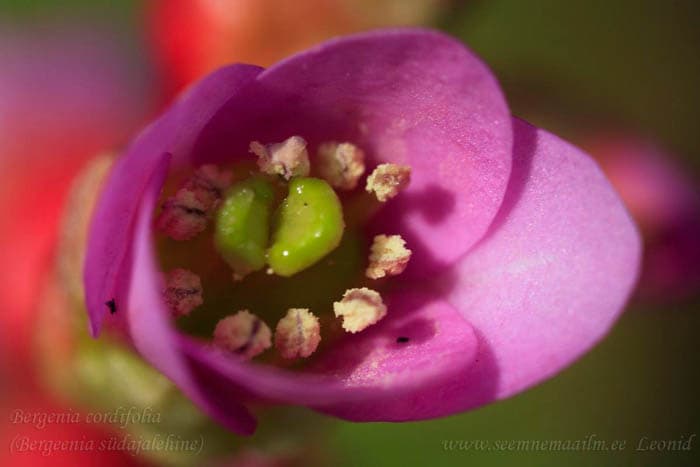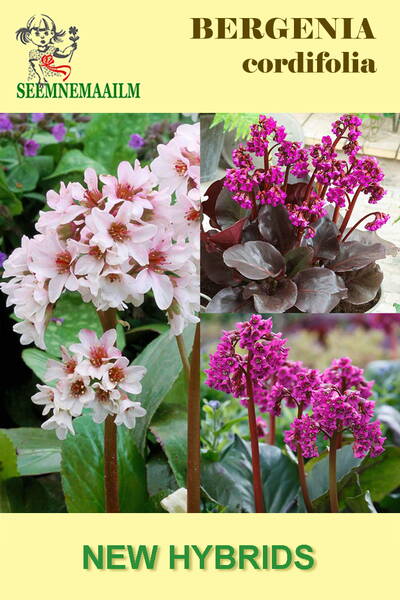Decorative until late autumn!
Perennial from the family Saxifragaceae.
Flowering plant height: 45 cm.
Color of inflorescences: from soft pink to dark red.
Natural flowering period: March - May.
Soil requirements: well-drained.
Winter hardiness zones: Z3 – Z8.
1.0 g = 6850 seeds.

Heart-leaf bergenia, Siberian tea, Elephants ears. Bot. syn.: Bergenia crassifolia, Saxifraga cordifolia Haw., Saxifraga crassifolia L.
Вergenia cordifolia (Haw.) A. Br.
Homeland: Altai.
Plant up to 40 cm tall. The leaves are round, heart-shaped, rough, dark green, overwintering under snow until autumn. The flowers are bell-shaped, lilac-pink or deep pink, collected in racemes, somewhat inclined. It blooms in May 20 days after the thick-leaved bergenia. In culture since 1779. Varieties with white and lavender flowers are known. Winter-hardy down to -40 °C.
Location: shade-tolerant, winter-hardy. Grows well in light, semi-shady and shady places. However, in an open sunny place they do not grow as luxuriantly as in a shaded place and have a somewhat depressed appearance. With frequent transplants they get sick.
In rocky areas they are planted on the north, northeast and northwest sides.
Soil: undemanding, but grows best in light, nutritious and well-drained soil. Soggy and heavy soils are undesirable.
Care: require regular watering. Clear the leaves in spring. Shorten long shoots. Long-term frosts are dangerous for flowers. It grows in one place for 7-8 years.
Reproduction: by dividing adult plants, cuttings or seeds.
Propagation by seeds is a long process: in the first two years, seedlings develop extremely slowly, forming low rosettes (2-2.5 cm), and require careful care, including regular watering. For the winter, it is advisable to cover the seedlings with a layer of dry leaves, which need to be removed in the spring. Seedlings tolerate picking well.
The best substrate is light turf soil, which can be replaced with a mixture of 1/3 loamy soil, 1/3 humus or compost, 1/3 sand.
The seeds do not need stratification, however, when sown in winter, seedlings are more abundant. When sown in early May, seedlings appear in the second half of the same month.
The best time to plant seedlings (seedlings) in a permanent place is the second half of the summer of the second year of plant life. By the end of the second year, the rosettes of leaves reach 8-10 cm.
The plant usually blooms 3-4 years after sowing. Cuttings are segments of above-ground creeping rhizomes up to 10-20 cm long. Under favorable conditions they take root easily, but an indispensable condition is the presence of at least three buds on them. It is best to take part of the rhizome with the apical bud.
Cuttings should be planted shallowly, no more than 1-2 cm, at a distance of 30-40 cm from each other. It is better to take cuttings from plants after flowering, that is, from May to August. The plant must take root before winter.
The bushes are divided once every five to six years in the first half of September. The resulting “divisions” are planted at a distance of 30-40 cm from each other. In the first two weeks after planting, abundant watering is required.
Use: beautiful in groups near bushes, in mixed ridges, on rocky areas. Decorative from spring to autumn.
Partners: thanks to the beautiful foliage, they look great in plantings with daylilies, aquilegias, astilbes, trolliuses, irises, speedwells, ferns, geraniums, periwinkles, and sedges.
Imagine: large shiny bergenia leaves pressed against the wall. In the spring, bright pink spiers of inflorescences rise above them, and in the fall the leaves will be covered with a reddish coating, but will not wither all winter.












